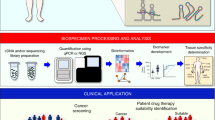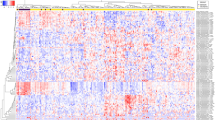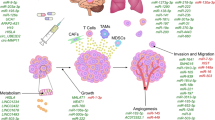Abstract
Here we performed a systematic search to identify breast-cancer-specific small noncoding RNAs, which we have collectively termed orphan noncoding RNAs (oncRNAs). We subsequently discovered that one of these oncRNAs, which originates from the 3′ end of TERC, acts as a regulator of gene expression and is a robust promoter of breast cancer metastasis. This oncRNA, which we have named T3p, exerts its prometastatic effects by acting as an inhibitor of RISC complex activity and increasing the expression of the prometastatic genes NUPR1 and PANX2. Furthermore, we have shown that oncRNAs are present in cancer-cell-derived extracellular vesicles, raising the possibility that these circulating oncRNAs may also have a role in non–cell autonomous disease pathogenesis. Additionally, these circulating oncRNAs present a novel avenue for cancer fingerprinting using liquid biopsies.
This is a preview of subscription content, access via your institution
Access options
Access Nature and 54 other Nature Portfolio journals
Get Nature+, our best-value online-access subscription
$29.99 / 30 days
cancel any time
Subscribe to this journal
Receive 12 print issues and online access
$209.00 per year
only $17.42 per issue
Buy this article
- Purchase on Springer Link
- Instant access to full article PDF
Prices may be subject to local taxes which are calculated during checkout






Similar content being viewed by others
Data Availability
All sequencing data generated for this study has been deposited in the Gene Expression Omnibus under the accession number GSE114366.
References
Tavazoie, S. F. et al. Endogenous human microRNAs that suppress breast cancer metastasis. Nature 451, 147–152 (2008).
Fish, L. et al. Muscleblind-like 1 suppresses breast cancer metastatic colonization and stabilizes metastasis suppressor transcripts. Genes Dev. 30, 386–398 (2016).
Vanharanta, S. et al. Loss of the multifunctional RNA-binding protein RBM47 as a source of selectable metastatic traits in breast cancer. eLife 3, e02734 (2014).
David, C. J., Chen, M., Assanah, M., Canoll, P. & Manley, J. L. HnRNP proteins controlled by c-Myc deregulate pyruvate kinase mRNA splicing in cancer. Nature 463, 364–368 (2010).
Chen, L.-Y. & Lingner, J. AUF1/HnRNP D RNA binding protein functions in telomere maintenance. Mol. Cell 47, 1–2 (2012).
Goodarzi, H. et al. Modulated expression of specific tRNAs drives gene expression and cancer progression. Cell 165, 1416–1427 (2016).
Goodarzi, H. et al. Endogenous tRNA-derived fragments suppress breast cancer progression via YBX1 displacement. Cell 161, 790–802 (2015).
Simanshu, D. K., Nissley, D. V. & McCormick, F. RAS proteins and their regulators in human disease. Cell 170, 17–33 (2017).
Bhargava, R. et al. EGFR gene amplification in breast cancer: correlation with epidermal growth factor receptor mRNA and protein expression and HER-2 status and absence of EGFR-activating mutations. Mod. Pathol. 18, 1027–1033 (2005).
Ren, R. Mechanisms of BCR–ABL in the pathogenesis of chronic myelogenous leukaemia. Nat. Rev. Cancer 5, 172–183 (2005).
Lin, R.-K. & Wang, Y.-C. Dysregulated transcriptional and post-translational control of DNA methyltransferases in cancer. Cell Biosci. 4, 46 (2014).
Wu, C.-I., Wang, H.-Y., Ling, S. & Lu, X. The ecology and evolution of cancer: the ultra-microevolutionary process. Annu. Rev. Genet. 50, 347–369 (2016).
Minn, A. J. et al. Distinct organ-specific metastatic potential of individual breast cancer cells and primary tumors. J. Clin. Invest. 115, 44–55 (2005).
Loo, J. M. et al. Extracellular metabolic energetics can promote cancer progression. Cell 160, 393–406 (2015).
Bak, R. O., Hollensen, A. K., Primo, M. N., Sørensen, C. D. & Mikkelsen, J. G. Potent microRNA suppression by RNA Pol II-transcribed ‘Tough Decoy’ inhibitors. RNA 19, 280–293 (2013).
Cooper, D. N., Berg, L. P., Kakkar, V. V. & Reiss, J. Ectopic (illegitimate) transcription: new possibilities for the analysis and diagnosis of human genetic disease. Ann. Med. 26, 9–14 (1994).
Margolin, A. A. et al. ARACNE: an algorithm for the reconstruction of gene regulatory networks in a mammalian cellular context. BMC Bioinformatics 7, S7 (2006).
Goodarzi, H. et al. Metastasis-suppressor transcript destabilization through TARBP2 binding of mRNA hairpins. Nature 513, 256–260 (2014).
Kim, B., Jeong, K. & Kim, V. N. Genome-wide mapping of DROSHA cleavage sites on primary microRNAs and noncanonical substrates. Mol. Cell 66, 258–269 (2017).
Ray, D. et al. A compendium of RNA-binding motifs for decoding gene regulation. Nature 499, 172–177 (2013).
Yang, Y.-C. T. et al. CLIPdb: a CLIP-seq database for protein–RNA interactions. BMC Genomics 16, 51 (2015).
Van Nostrand, E. L. et al. Robust transcriptome-wide discovery of RNA-binding protein binding sites with enhanced CLIP (eCLIP). Nat. Methods 13, 508–514 (2016).
Goodarzi, H. et al. Systematic discovery of structural elements governing stability of mammalian messenger RNAs. Nature 485, 264–268 (2012).
Kishore, S. et al. A quantitative analysis of CLIP methods for identifying binding sites of RNA-binding proteins. Nat. Methods 8, 559–564 (2011).
Helwak, A., Kudla, G., Dudnakova, T. & Tollervey, D. Mapping the human miRNA interactome by CLASH reveals frequent noncanonical binding. Cell 153, 654–665 (2013).
Elemento, O., Slonim, N. & Tavazoie, S. A universal framework for regulatory element discovery across all genomes and data types. Mol. Cell 28, 337–350 (2007).
Bos, P. D. et al. Genes that mediate breast cancer metastasis to the brain. Nature 459, 1005–1009 (2009).
Fiskaa, T. et al. Distinct small RNA signatures in extracellular vesicles derived from breast cancer cell lines. PLoS ONE 11, e0161824 (2016).
Zhou, W. et al. Cancer-secreted miR-105 destroys vascular endothelial barriers to promote metastasis. Cancer Cell 25, 501–515 (2014).
Ainsztein, A. M. et al. The NIH Extracellular RNA Communication Consortium. J. Extracell. Vesicles 4, 27493 (2015).
Hooten, N. N. et al. Age-related changes in microRNA levels in serum. Aging 5, 725–740 (2013).
Wu, X. et al. De novo sequencing of circulating miRNAs identifies novel markers predicting clinical outcome of locally advanced breast cancer. J. Transl. Med. 10, 42 (2012).
Roth, C. et al. Circulating microRNAs as blood-based markers for patients with primary and metastatic breast cancer. Breast Cancer Res. 12, R90 (2010).
Huo, D., Clayton, W. M., Yoshimatsu, T. F., Chen, J. & Olopade, O. I. Identification of a circulating microRNA signature to distinguish recurrence in breast cancer patients. Oncotarget 7, 55231–55248 (2016).
Cuk, K. et al. Plasma microRNA panel for minimally invasive detection of breast cancer. PLoS ONE 8, e76729 (2013).
Kodahl, A. R. et al. Novel circulating microRNA signature as a potential non-invasive multi-marker test in ER-positive early-stage breast cancer: a case control study. Mol. Oncol. 8, 874–883 (2014).
Langmead, B. & Salzberg, S. L. Fast gapped-read alignment with Bowtie 2. Nat. Meth. 9, 357–359 (2012).
Quinlan, A. R. & Hall, I. M. BEDTools: a flexible suite of utilities for comparing genomic features. Bioinformatics 26, 841–842 (2010).
Love, M. I., Huber, W. & Anders, S. Moderated estimation of fold change and dispersion for RNA-seq data with DESeq2. Genome Biol. 15, 550 (2014).
DeRose, Y. S. et al. Tumor grafts derived from women with breast cancer authentically reflect tumor pathology, growth, metastasis and disease outcomes. Nat. Med. 17, 1514–1520 (2011).
Fabregat, A. et al. The reactome pathway knowledgebase. Nucleic Acids Res. 46, D649–D655 (2018).
Rehmsmeier, M., Steffen, P., Hochsmann, M. & Giegerich, R. Fast and effective prediction of microRNA/target duplexes. RNA 10, 1507–1517 (2004).
Moore, M. J. et al. Mapping Argonaute and conventional RNA-binding protein interactions with RNA at single-nucleotide resolution using HITS-CLIP and CIMS analysis. Nat. Protoc. 9, 263–293 (2014).
Acknowledgements
We thank D. Ruggero, D. Erle, F. Feng, S. Tavazoie and S. Tavazoie for reading earlier versions of this manuscript; D. Erle and P. Godoy for providing early access to their serum smRNA profiles; B. Hann and the Preclinical Therapeutics core as well as the Laboratory Animal Resource Center (LARC); S. Kilinc for her assistance with extracellular vesicle size analysis; F. Fattahi for helpful discussions; and J. Massagué for providing cell lines. We are also grateful for the genomic data contributed by the TCGA Research Network, including donors and researchers. We acknowledge the UCSF Center for Advanced Technology (CAT) for high-throughput sequencing and other genomic analyses; and support from our colleagues at the Breast Oncology Program (Helen Diller Family Comprehensive Cancer Center). This work was supported by the NIH (R01GM123977 and R00CA194077), Friends for an Earlier Breast Cancer Test, the American Cancer Society (130920-RSG-17-114-01-RMC) and the Goldberg-Benioff Fund in Translational Research. S.Z. was supported through the HHMI Medical Research Fellowship. J.X.Y. is an NSF GRFP fellow. A.G. was supported by the CDMRP Breast Cancer Research Program W81XWH-12-1-0272 and W81XWH-16-1-0603.
Author information
Authors and Affiliations
Contributions
H.G. conceived and designed the study. L.F. and S.Z. performed RNA isolations and prepared smRNA-seq libraries. J.X.Y. performed FACS analysis. S.Z., B.C. and H.G. performed mouse experiments. H.G. performed computational analyses. A.G. and A.Y.Z. contributed data from PDX models. L.F., S.Z. and H.G. wrote the manuscript. H.G. supervised the project.
Corresponding author
Ethics declarations
Competing interests
The authors declare no competing interests.
Additional information
Publisher’s note: Springer Nature remains neutral with regard to jurisdictional claims in published maps and institutional affiliations.
Supplementary information
Supplementary Text and Figures
Supplementary Figures 1–6
Rights and permissions
About this article
Cite this article
Fish, L., Zhang, S., Yu, J.X. et al. Cancer cells exploit an orphan RNA to drive metastatic progression. Nat Med 24, 1743–1751 (2018). https://doi.org/10.1038/s41591-018-0230-4
Received:
Accepted:
Published:
Issue Date:
DOI: https://doi.org/10.1038/s41591-018-0230-4
This article is cited by
-
Circulating tumor nucleic acids: biology, release mechanisms, and clinical relevance
Molecular Cancer (2023)
-
Pan-cancer analysis of mRNA stability for decoding tumour post-transcriptional programs
Communications Biology (2022)
-
Transcriptional coregualtor NUPR1 maintains tamoxifen resistance in breast cancer cells
Cell Death & Disease (2021)
-
The network of non-coding RNAs and their molecular targets in breast cancer
Molecular Cancer (2020)



